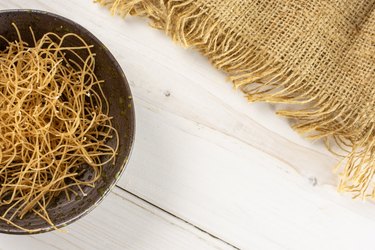
Durum wheat, a hard variety of spring wheat, is a whole grain whose flour is found in many familiar products including pastas, couscous and semolina flour. Durum wheat flour — varieties include whole wheat and white — has a high protein and elasticity content that is preferred for making pasta.
Durum Wheat Uses
Video of the Day
There are several types of flour and products that are milled from durum wheat, including semolina, whole-wheat durum flour, white durum flour and bulgur wheat, made by boiling durum wheat grains.
Video of the Day
Semolina flour, typically used in durum pasta, is durum wheat grains that have been coarsely ground. Other well-known products made from durum wheat flour include couscous, which is formed by rolling a paste of semolina and water into tiny round pieces that are then steamed.
Durum wheat has a high protein content relative to normal wheat. A dough made with durum wheat flour has high extensibility, which means it can be stretched out into long pieces without breaking, such as when making pasta. However, it has a low elasticity, so it doesn't bounce back like a normal wheat dough when kneaded — making it less than ideal for using in baking bread.
If a durum wheat flour is listed on the package as "stone ground" (semolina is often listed as "stone ground," for example), it denotes that the grains are crushed between stones during processing and the bran, germ and endosperm of the grain are never separated. The nutritional value of durum flour depends on how it was processed. Whole-wheat durum flour contains more nutrients than white durum flour.
Read more: The Health Benefits of Semolina
Durum Vs. Whole Wheat
An article published by Harvard T. Chan School of Public Health describes whole-wheat grains as a "complete package" of health benefits, as opposed to refined grains, which are stripped of nutrients in the refining process.
Whole-grain kernels contain three parts: the bran, germ and endosperm. The bran is the fiber-rich outer layer that supplies B vitamins, iron, copper, zinc, magnesium, antioxidants and phytochemicals.
According to Harvard, phytochemicals are natural chemical compounds in plants that have been researched for their role in disease prevention. The germ is the core of the seed where growth occurs; it is rich in healthy fats, vitamin E, B vitamins, phytochemicals and antioxidants. The endosperm is the interior layer that holds carbohydrates, protein and small amounts of some B vitamins and minerals.
Refining wheat into white flour removes up to 75 percent of its phytochemicals during the milling process. Milling also removes some of the fats and fiber. Whole-wheat flour contains more nutrients and fiber than white flour that doesn't contain the bran or germ.
Is Durum a Whole Grain?
The question of whether durum or whole wheat is healthier should be rephrased as, is a whole grain healthier than a refined grain? The USDA says yes. Its 2015-2020 Dietary Guidelines list the recommended amount of grains in a 2,000-calorie level at 6-ounce equivalents per day. At least half of this amount should be whole grains.
Grains are either whole or refined, the USDA specifies. Whole grains include brown rice, quinoa and oats, among others. As mentioned, whole grains contain the entire kernel, including the endosperm, bran and germ as compared with refined grains that have dietary fiber, iron and other nutrients removed during processing.
Going further, the Whole Grains Council attempts to simplify ingredients lists on packaged foods. It identifies whole-grain ingredients as including whole grain [name of grain], whole wheat, whole [other grain], stoneground whole [grain], brown rice, oats, oatmeal (including old-fashioned oatmeal and instant oatmeal) and wheatberries. However, it cautions that ingredients with this wording may or may not actually be a whole grain unless the wording "whole grain" is also included.
Durum wheat in its natural state is a whole grain. But when you purchase products that contain durum flour, you may want to read the ingredients label carefully to determine if it has been more refined by the time it ends up in the package you find on the shelf.
Read more: 13 Powerful Grains and Seeds